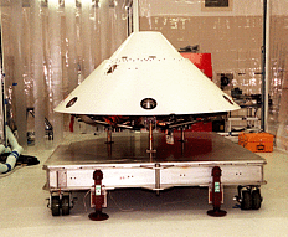Click on image for full size
Courtesy of NASA
Related links:
Still Looking for Lander
News story originally written on January 10, 2000
Amongst reports that the Mars Polar Lander fell into a deep canyon, scientists are reporting the cause of the disaster is still unknown.Organizers of the mission also pointed out they knew the canyon was near the landing site. A recent article in the Post suggested scientists didn't know the canyone existed. This huge 'hole' is 30 X 8 miles with slopes greater than 20 percent. Scientists say that slopes greater than 16 percent could cause the Lander to topple over.
“It’s closer than we wanted to be,” said Richard Zurek, the mission’s project scientist. “We knew about this deep valley and the crater right from the beginning of our site selection. We knew this was an area we didn’t particularly want to set down in.”
Still, Zurek says it was the safest possible landing site. Strong winds of 75 miles per hour would be necessary from the surface to 30 miles in altitude for the spacecraft to be blown into the pit. Scientists are not ruling this out, but they believe it is more likely there was a failure aboard the craft.
“Definitely, the surface is one possible explanation of the apparent loss of the Mars Polar Lander,” Zurek said. “There’s nothing that points to that as the sole reason for that failure.”
The Mars Surveyor is mapping the area near the landing site, looking for any evidence. Until then, leaders of the mission are taking the blame. “I don’t think any of us are off
the hook here,” Zurek said.














